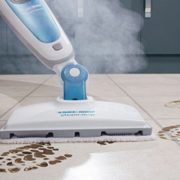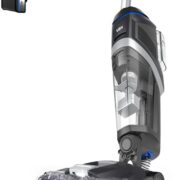In this article, you will learn all about steam cleaners and how they can be used for mold removal. We will provide you with an in-depth guide to help you understand the process of using steam cleaners effectively to eliminate mold. Whether you are dealing with a small area or a larger infestation, this guide will provide you with the knowledge you need to tackle the problem.
Firstly, let’s delve into why steam cleaners are effective for mold removal. Steam cleaners use high temperatures and moisture to kill mold spores and remove them from surfaces. The heat from the steam kills the mold while the moisture helps to loosen it from the surface. This makes steam cleaners a great tool for mold removal as they not only eliminate the existing mold, but also prevent its regrowth. Additionally, steam cleaners are chemical-free, making them a safer and more environmentally friendly option for mold removal.
What are Steam Cleaners?
Steam cleaners are versatile cleaning devices that use the power of steam to remove dirt, grime, and stains from various surfaces. They are an effective and environmentally friendly alternative to traditional cleaning methods that often require the use of harsh chemicals. Steam cleaners work by heating water to produce steam, which is then directed onto the surface being cleaned. This high-temperature steam effectively kills bacteria, germs, and mold, making it a highly effective tool for mold removal.
Understanding Mold
Before diving into the details of using steam cleaners for mold removal, it is important to understand what mold is and how it can affect our health and living spaces.
Common Types of Mold
There are various types of mold that can infest our homes and cause health issues. Some common types include:
- Black Mold (Stachybotrys chartarum): This type of mold is a toxic and potentially dangerous variety that produces mycotoxins. It is usually black in color and thrives in areas with excessive moisture.
- Aspergillus: Aspergillus is a common type of mold that can be found indoors and outdoors. It produces allergens and can cause allergic reactions and respiratory issues.
- Cladosporium: Cladosporium is a mold commonly found in indoor and outdoor environments. While it is not as dangerous as black mold, it can still cause respiratory problems, especially in individuals with allergies or compromised immune systems.
Causes of Mold Growth
Mold thrives in damp, humid environments. Some common causes of mold growth in homes include:
- Excessive moisture due to leaks, flooding, or condensation.
- Poor ventilation, which results in high humidity levels.
- Lack of sunlight, especially in areas that are constantly shaded.
- Organic materials such as wood, carpet, or fabric that provides a suitable breeding ground for mold.
Health Risks Associated with Mold
Exposure to mold can lead to a range of health issues, especially for individuals with allergies, asthma, or weakened immune systems. Some common health risks associated with mold include:
- Allergic reactions such as sneezing, coughing, and skin irritations.
- Respiratory problems, including wheezing, chest tightness, and difficulty breathing.
- Headaches, fatigue, and worsening of existing respiratory conditions.
- Long-term exposure to certain types of mold, such as black mold, can even lead to more serious health issues.
This image is property of images.unsplash.com.
Steam Cleaners and Mold Removal
Now that you have a basic understanding of mold, let’s explore how steam cleaners can effectively remove mold from your home.
Effectiveness of Steam Cleaners in Mold Removal
Steam cleaners are highly effective in killing mold and mold spores. The high temperatures produced by steam cleaners are capable of killing mold at its source, eliminating the need for harsh chemicals or scrubbing. Additionally, steam can penetrate porous surfaces where mold can hide, ensuring a thorough removal process.
Benefits of Using Steam Cleaners for Mold Removal
Using steam cleaners for mold removal offers several benefits, including:
- Chemical-free Cleaning: Steam cleaners use only water, eliminating the need for chemical-based cleaners that can be harmful to both humans and the environment.
- Kills Mold at its Source: The high temperatures produced by steam cleaners effectively kill mold and destroy mold spores, ensuring that the problem is eradicated from its root.
- All-in-one Cleaning Solution: Steam cleaners are versatile and can be used on various surfaces, including walls, floors, countertops, and upholstery. This makes them a convenient and cost-effective tool for mold removal.
Preparation for Mold Removal
Before you start using your steam cleaner to remove mold, it is essential to properly prepare and identify the areas affected by mold.
Identifying Mold Infestation Areas
Begin by visually inspecting your home for areas with visible signs of mold growth. Pay attention to areas that are prone to moisture, such as bathrooms, basements, and kitchens. Look for any discoloration, musty odors, or peeling paint, as these can indicate the presence of mold.
Protective Measures Before Using Steam Cleaners
It is crucial to take some precautionary measures before using steam cleaners for mold removal. These measures include:
- Wear Protective Gear: Put on gloves, goggles, and a mask to protect yourself from potential mold spores and the hot steam.
- Ventilate the Area: Open windows and doors to ensure proper ventilation during the cleaning process. This helps to disperse any mold spores or steam that may accumulate.
- Remove Clutter and Valuables: Clear the area of any furniture, carpets, or items that could be damaged by steam or mold spores during the cleaning process.
Using Steam Cleaners for Mold Removal
Now that you are ready to start the mold removal process, here is a step-by-step guide on how to effectively use steam cleaners for mold removal.
Step-By-Step Guide to Removing Mold with Steam Cleaners
- Prepare the steam cleaner: Fill the steam cleaner’s water tank with clean water according to the manufacturer’s instructions. Ensure that the steam cleaner is properly assembled and plugged into a power source.
- Pre-treat the affected area: Use a mild detergent or vinegar solution to pre-treat the mold-infested surface. This helps to loosen and remove any visible mold before using the steam cleaner.
- Steam clean the area: Hold the steam cleaner’s nozzle a few inches away from the surface and move it slowly across the affected area. The high-temperature steam will kill the mold and loosen it from the surface.
- Wipe away the loosened mold: Use a clean cloth or sponge to wipe away the loosened mold. Be sure to dispose of the cloth or sponge properly to prevent cross-contamination.
- Repeat if necessary: For stubborn mold stains, repeat the steam cleaning process until the mold is completely removed.
Recommended Settings and Techniques
When using a steam cleaner for mold removal, it is important to follow these recommended settings and techniques for optimal results:
- Temperature: Set the steam cleaner to the highest temperature possible to ensure that the steam is hot enough to kill mold effectively.
- Pressure: Adjust the steam cleaner’s pressure according to the surface being cleaned. Higher pressure settings are suitable for hard surfaces, while lower pressure settings are recommended for more delicate surfaces.
- Distance: Maintain a distance of a few inches between the steam cleaner’s nozzle and the surface being cleaned. This allows the steam to effectively reach the mold without causing damage.
Additional Tips for Effective Mold Removal
In addition to using steam cleaners, there are a few additional tips that can help ensure a thorough mold removal process.
Proper Ventilation and Air Circulation
During and after the steam cleaning process, it is crucial to have proper ventilation and air circulation to prevent the mold from returning. Open windows and use fans to promote airflow and dry the area effectively.
Drying Techniques After Steam Cleaning
After steam cleaning, thoroughly dry the cleaned area to prevent any moisture from remaining, as mold thrives in damp environments. Use fans or dehumidifiers to speed up the drying process and ensure that the area is completely dry.
Preventing Mold Regrowth
Once you have successfully removed the mold from your home, it is essential to take preventive measures to avoid its regrowth.
Maintenance and Regular Cleaning
Regularly clean and maintain your home to prevent mold from reoccurring. Keep moisture levels low, fix any leaks promptly, and ensure proper ventilation in areas prone to moisture.
Reducing Moisture in Indoor Spaces
To reduce the risk of mold growth, there are a few additional steps you can take to keep moisture levels under control:
- Use dehumidifiers in damp areas to minimize humidity.
- Fix any plumbing leaks or damaged pipes to prevent water buildup.
- Ensure proper airflow and ventilation throughout your home by opening windows and using exhaust fans in bathrooms and kitchens.
When to Seek Professional Help
While steam cleaners are highly effective in removing mold, there are instances where professional assistance may be necessary.
Severe Mold Infestations
If you are dealing with a severe mold infestation or a large area of mold growth, it is advisable to seek professional mold remediation services. Professionals have the expertise and specialized equipment to safely and effectively remove mold in such cases.
Hidden Mold Areas
If you suspect mold in hidden areas such as behind walls or under flooring, it is best to seek professional help. They have the tools and knowledge to identify and properly treat hidden mold growth without causing further damage.
Safety Considerations
When using steam cleaners for mold removal, it is important to prioritize safety to avoid any potential harm.
Protective Gear and Clothing
Always wear gloves, goggles, and a mask to protect yourself from potential mold spores and the hot steam emitted by the cleaner. This reduces the risk of allergic reactions and steam burns.
Preventing Steam Burns
To prevent steam burns, never touch the steam directly or aim it towards yourself or others. Steam cleaners reach high temperatures and can cause burns if mishandled.
Conclusion
Using steam cleaners for mold removal is an effective, safe, and environmentally friendly option. The high temperatures produced by steam cleaners effectively kill mold and mold spores, ensuring a thorough cleaning process. By following the outlined steps and taking necessary precautions, you can successfully eliminate mold from your home and create a healthier living environment. Regular maintenance, reducing moisture levels, and proper ventilation are crucial for preventing mold regrowth. Remember, when dealing with severe mold infestations or hidden mold areas, it is wise to seek professional assistance for a comprehensive and safe remediation process.




